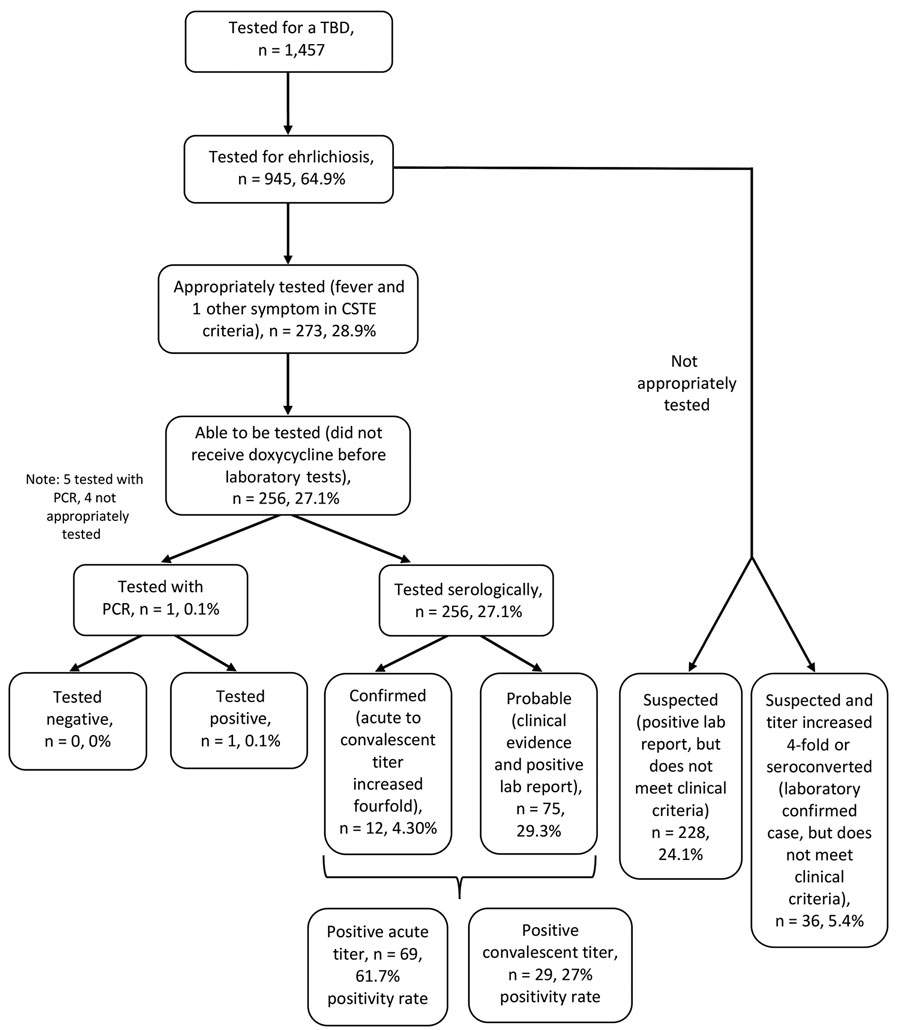Volume 31, Number 2—February 2025
Research
Contribution of Limited Molecular Testing to Low Ehrlichiosis Diagnosis in High Incidence Area, North Carolina, USA
Figure

Figure. Flowchart describing use of testing to diagnosis ehrlichiosis within the University of North Carolina health system, March 24, 2022–April 14, 2023. CSTE criteria are described in (18). CSTE, Council of State and Territorial Epidemiologists; TBD, tickborne disease.
References
- Centers for Disease Control and Prevention. Ehrlichiosis epidemiology and statistics [cited 2023 May 13]. https://www.cdc.gov/ehrlichiosis/stats
- Boyce RM, Sanfilippo AM, Boulos JM, Cleinmark M, Schmitz J, Meshnick S. Ehrlichia Infections, North Carolina, USA, 2016. Emerg Infect Dis. 2018;24:2087–90. DOIPubMedGoogle Scholar
- Nichols Heitman K, Dahlgren FS, Drexler NA, Massung RF, Behravesh CB. Increasing incidence of ehrlichiosis in the United States: a summary of national surveillance of Ehrlichia chaffeensis and Ehrlichia ewingii infections in the United States, 2008–2012. Am J Trop Med Hyg. 2016;94:52–60. DOIPubMedGoogle Scholar
- Kuriakose K, Pettit AC, Schmitz J, Moncayo A, Bloch KC. Assessment of risk factors and outcomes of severe ehrlichiosis infection. JAMA Netw Open. 2020;3:
e2025577 . DOIPubMedGoogle Scholar - Hamburg BJ, Storch GA, Micek ST, Kollef MH. The importance of early treatment with doxycycline in human ehrlichiosis. Medicine (Baltimore). 2008;87:53–60. DOIPubMedGoogle Scholar
- Biggs HM, Behravesh CB, Bradley KK, Dahlgren FS, Drexler NA, Dumler JS, et al. Diagnosis and management of tickborne rickettsial diseases: Rocky Mountain spotted fever and other spotted fever group rickettsioses, ehrlichioses, and anaplasmosis—United States. MMWR Recomm Rep. 2016;65:1–44. DOIPubMedGoogle Scholar
- Bakken JS, Haller I, Riddell D, Walls JJ, Dumler JS. The serological response of patients infected with the agent of human granulocytic ehrlichiosis. Clin Infect Dis. 2002;34:22–7. DOIPubMedGoogle Scholar
- Dumler JS, Madigan JE, Pusterla N, Bakken JS. Ehrlichioses in humans: epidemiology, clinical presentation, diagnosis, and treatment. Clin Infect Dis. 2007;45(Suppl 1):S45–51. DOIPubMedGoogle Scholar
- Zychowski DL, Alvarez C, Abernathy H, Giandomenico D, Choudhary SK, Vorobiov JM, et al. Tick-borne disease infections and chronic musculoskeletal pain. JAMA Netw Open. 2024;7:
e2351418 . DOIPubMedGoogle Scholar - Mokashi NV, Brown Marusiak A, Giandomenico D, Cleinmark M, Schmitz JL, Boyce RM. Does paging clinicians about tick-borne disease serological results impact clinical care? A retrospective analysis of 70 cases in North Carolina. Am J Trop Med Hyg. 2024;110:815–8. DOIPubMedGoogle Scholar
- Council of State and Territorial Epidemiologists. Update to public health reporting and national notification for ehrlichiosis. Vol. 23-ID-04. 2023 [cited 2024 Feb 2]. https://cdn.ymaws.com/www.cste.org/resource/resmgr/ps/ps_2023/23-ID-04_Ehrlichiosis.pdf
- North Carolina Division of Public Health. Ehrlichiosis surveillance from 2016–2021 [cited 2023 Jan 10]. https://epi.dph.ncdhhs.gov/cd/ehrlichiosis/EhrlichiosisSurveillanceSummary2021.pdf
- Brown Marusiak A, Hollingsworth BD, Abernathy H, Alejo A, Arahirwa V, Mansour O, et al. Patterns testing for tick-borne diseases and implications for surveillance in the southeastern US. JAMA Netw Open. 2022;5:
e2212334 . DOIPubMedGoogle Scholar - Eshoo MW, Crowder CD, Li H, Matthews HE, Meng S, Sefers SE, et al. Detection and identification of Ehrlichia species in blood by use of PCR and electrospray ionization mass spectrometry. J Clin Microbiol. 2010;48:472–8. DOIPubMedGoogle Scholar
- The University of North Carolina Health System. 2021 Annual report [cited 2023 Dec 20]. https://www.unchealthcare.org/app/files/public/9676dff4-3a41-42ce-b177-1a25647a0c62/pdf-UNC_Health_2021_Annual_Report.pdf
- Mayo Foundation for Medical Education and Research. TEST ID: EPCRB—Ehrlichia/Anaplasma, molecular detection, PCR, blood [cited 2023 Dec 21]. https://www.mayocliniclabs.com/test-catalog/Overview/618301#Performance
- Harris PA, Taylor R, Thielke R, Payne J, Gonzalez N, Conde JG. Research electronic data capture (REDCap)—a metadata-driven methodology and workflow process for providing translational research informatics support. J Biomed Inform. 2009;42:377–81. DOIPubMedGoogle Scholar
- Council of State and Territorial Epidemiologists. Revision of the national surveillance case definition for ehrlichiosis (Ehrlichiosis/Anaplasmosis). Vol. 07-ID-03. 2007 [cited 2024 Feb 21]. https://cdn.ymaws.com/www.cste.org/resource/resmgr/PS/07-ID-03.pdf
- Lee S, Kakumanu ML, Ponnusamy L, Vaughn M, Funkhouser S, Thornton H, et al. Prevalence of Rickettsiales in ticks removed from the skin of outdoor workers in North Carolina. Parasit Vectors. 2014;7:607. DOIPubMedGoogle Scholar
- Wolf L, McPherson T, Harrison B, Engber B, Anderson A, Whitt P. Prevalence of Ehrlichia ewingii in Amblyomma americanum in North Carolina. J Clin Microbiol. 2000;38:2795. DOIPubMedGoogle Scholar
Page created: January 13, 2025
Page updated: January 31, 2025
Page reviewed: January 31, 2025
The conclusions, findings, and opinions expressed by authors contributing to this journal do not necessarily reflect the official position of the U.S. Department of Health and Human Services, the Public Health Service, the Centers for Disease Control and Prevention, or the authors' affiliated institutions. Use of trade names is for identification only and does not imply endorsement by any of the groups named above.